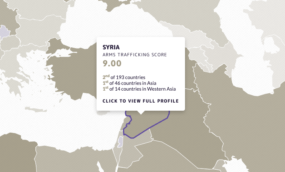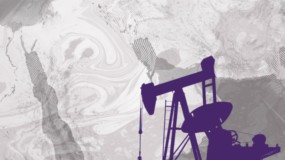Posted on 08 Sep 2023
From everyday painkillers to drugs for treating serious illnesses, Western Asia is awash with counterfeit medicines, which account for more than a third of its total pharmaceutical supply. With healthcare sectors already on the brink of collapse in many countries in the region, the pervasiveness of this illicit market adds yet another layer of challenges.
Western Asia is facing a deepening public health crisis, with almost all countries in the region reporting medicine shortages in recent years. Countries at the forefront of the region’s humanitarian challenges, including Iraq, Lebanon, Syria, Turkey, Iran and Yemen, are bearing the brunt of the problem. Unprecedented health needs, exacerbated by conflict-driven displacement and the long-term effects of COVID-19, have created shortages in medical supplies and severely undermined the ability of governments to provide affordable healthcare to their citizens. As much as 35 per cent of the region’s medicines – from antibiotics and vaccines to insulin pens and chemotherapy drugs – are illicitly sourced and enter the region’s medical supply chains.
This illicit trade addresses two major issues in the region. In response to shortages, a plethora of ‘medicines’ that are otherwise unavailable in pharmacies and hospitals can easily be found on the black market, although many are counterfeit. In desperation, citizens often pay exorbitant prices for these makeshift medicines. Reports from Syria and Lebanon, for example, show that counterfeit medicines can cost between 10 and 50 times more than their legitimate counterparts.
Conversely, even medicines that are widely available in pharmacies are still highly sought after on the black market. In these cases, counterfeit medicines are marketed at lower prices than those they imitate, attracting a growing market who cannot afford the original. While the issue of affordability mostly affects the region’s most vulnerable groups – including those living in impoverished rural areas, ethnic minorities or refugees – the search for cheaper medicine is increasingly common among the region’s middle class. High unemployment rates, rising living costs and a host of other economic hardships, as well as damaging government cuts to much-needed medicine subsidies in countries such as Lebanon and Iran, all contribute to the problem.
A deadly business
In the face of Western Asia’s healthcare crises, turning to black market medicine comes at a price. In an effort to avoid detection and to deceive consumers and authorities, criminal groups go to great lengths to ensure that their counterfeit medicines look exactly like the real thing. Some shipments are even labelled with the same official serial numbers as those used by legitimate manufacturers, which criminal groups may obtain through corrupt contacts in the healthcare sector. At first glance, these pills may appear authentic, having an identical shape, colour and packaging as the medicine they are imitating. However, not only do these counterfeits often lack active ingredients, they may also contain dangerous substances, including paint, chalk or even rat poison – posing serious health risks to those who consume them.
At best, they offer little or no treatment for the underlying condition. At worst, they can be deadly. According to the World Health Organization (WHO), counterfeit medicines are responsible for tens of thousands of deaths worldwide each year. In Israel, for example, the rapid spread of counterfeit Phen Q pills has prompted multiple warnings from the Ministry of Health. These pills resemble medications used to treat obesity and diabetes, but they have been found to contain high levels of MDMA and other chemicals linked to psychiatric and cardiac complications, and have reportedly led to several hospitalizations.
Closely related to counterfeit medicines is the problem of diversion of legitimate products. Criminal groups illegally obtain pharmaceuticals through corruption or theft and divert them into illicit channels, often generating high profit margins. In Syria, for example, rebel groups and pro-Assad militias have been known to capitalize on the country’s decade-long instability by looting hospitals’ medical supplies.
Illegal diversion of medicines often goes hand in hand with poor transportation and storage practices, including falsification of expiration dates. In 2022, 10 young children died in a Yemeni hospital after being injected with expired and ‘bacterially contaminated’ medicines that were later found to have been smuggled into the country. In some cases, diverted medicines are sold across borders in countries where black market prices are higher. It is reported that an estimated 40 to 50 per cent of all medicines available in the Kurdish region are believed to have been smuggled into the territory from neighbouring areas in Turkey and Iran.
Although the impact of counterfeit medicines is disproportionately felt in a few countries, the oil-rich Gulf states are not immune. Recent seizures in Saudi Arabia, Bahrain and the United Arab Emirates (UAE) suggest that criminals are adapting to a growing demand for homeopathic medicines or those produced for non-medical purposes, such as enhancing sports performance or weight loss. In December 2022, Emirati authorities issued a public warning about the circulation of weight loss pills containing sibutramine or phenolphthalein, ingredients banned in most countries because of their suspected links to cancer and heart attacks. These drugs have gained popularity and are being actively promoted through online platforms such as Instagram and TikTok.
Legal sector infiltration
A key concern regarding Western Asia’s black market for medicines lies in the fact that a considerable share of drugs are creeping into the legal pharmaceutical sector, including into hospitals and pharmacies. For example, in war-torn Yemen, an estimated 30 per cent of all seemingly legitimate medicines enter the country through illicit channels. With the Houthi militias controlling a significant portion of the pharmaceutical industry (less than half of the country’s 13 000 pharmacies have government-approved licences), they are reportedly engaged in large-scale smuggling of medicines from abroad to fill the critical supply gap caused by the country’s deteriorating infrastructure. In Yemen, there have been reports of the militia blackmailing pharmacy owners and doctors to distribute these illicit medicines. Those who refuse to participate in the illicit trade face intimidation, including the threat of non-renewal of their licences.
In some cases, official public and private institutions are actively involved in the counterfeit medicines market. In Iraq, a major corruption scandal unfolded in 2022 involving a pharmaceutical company operating under a 10-year contract with the Ministry of Health. It was alleged that counterfeit and substandard medicines from India and China were being smuggled into Iraq, mainly across its porous border with Iran.
The increasingly blurred line between licit and illicit medicine supply chains in Western Asia is largely due to technological advances in the global pharmaceutical industry. In particular, the rise of digital pharmacies has been identified by the WHO as a leading cause of the global increase in counterfeit medicines. These digital platforms provide additional opportunities to disguise the origin of medicines, challenging even well-intentioned and trained pharmacists who struggle to distinguish between counterfeit and genuine medicines, enabling illicit products to infiltrate public clinics.
In addition to its role as a destination zone, Western Asia is also a significant transit hub for counterfeit medicines destined for Europe or Africa. The region’s porous borders, inadequate regulatory frameworks and ineffective or corrupt law enforcement agencies make it an attractive trafficking corridor for criminals operating in Asia. Ingredients for counterfeit medicines are sourced from countries such as India and China, and sold to local criminal groups in Western Asia, who handle the final stages of production, packaging and distribution. For example, there have been reports of Lebanon’s Hezbollah selling counterfeit medicines sourced from China in Europe. These medicines pass through Western Asia, where they are repackaged to appear to be of European origin.
As one of the fastest-growing criminal activities in the world, the counterfeit drug trade in Western Asia and beyond generates millions of dollars in revenue for criminal groups, with global data estimating that profit margins from counterfeit drugs are 10 to 25 times higher than those from other narcotics. As criminal organizations increasingly exploit this highly lucrative market, governments are falling behind in addressing the problem. Although the COVID-19 pandemic highlighted the pervasiveness of the market, governments often fail to recognize its criminal underpinnings, viewing it as a matter of copyright infringement or a purely public health concern. To combat the problem effectively, it is essential that the issue of counterfeit medicines is recognized and integrated into broader drug and crime control strategies. Equally important is improving access to affordable healthcare services to reduce demand for counterfeit medicines and mitigate their harmful effects on society.



